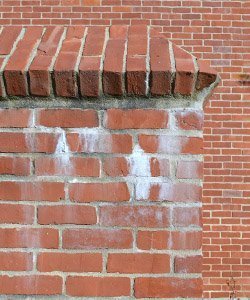Efflorescence Explanation
Efflorescence is a natural and random occurrence inherent in concrete products. It can materialize at any time following the completion of a project and it does not mean that the product is defective or damaged.
Calcium in the concrete is carried to the surface by moisture and when it reacts to carbon dioxide in the air it can leave a white haze on the product.
The structural integrity of the product is not compromised by efflorescence.
There are also specially designed cleaners to remove efflorescence, but in most cases the recommended procedure is to allow it to dissipate over time.
Efflorescence is not covered under the C&D warranty, and customers should consult with their installers to discuss the best remedy should it occur.
Efflorescence is a whitish powder-like deposit which can appear on concrete products. When cement hydrates (hardens after adding water), a significant amount of calcium hydroxide is formed. The calcium hydroxide is soluble in water and migrates by capillary action to the surface of the concrete. A reaction occurs between the calcium hydroxide and carbon dioxide (from the air) to form calcium carbonate, then called efflorescence. Efflorescence does not affect the structural performance or durability of concrete pavers.
The reaction that takes place is the formation of water-soluble calcium bicarbonate from calcium carbonate, carbon dioxide and water. It may appear immediately or within months following installation. Efflorescence may reach its peak in as short as 60 days after installation. It may remain for months and some of it may wear away. If installation takes place during a dry period of the year, the next cycle of wet weather may sometimes be necessary for efflorescence to materialize. If there is a need to remove deposits before they wear away, best results can be obtained by using a proprietary efflorescence remover. The acid in proprietary cleaning chemicals is buffered and blended with other chemicals to provide effective cleaning without damage to the paver surface. Always refer to the chemical company supplying the chemicals for recommendations on proper dilution and application of chemicals for removal of efflorescence. They are generally applied in sections beginning at the top slope of the pavement. If the area is large, a sprayer is an efficient means to apply the cleaner. The chemicals are scrubbed on the surface, and then rinsed away. Results can be verified after letting the area dry for at least 24 hours. In most instances one application is sufficient. However, in severe instances of efflorescence, a second application may be necessary. Contact the manufacturer of the cleaning product to determine if a second application will not discolor the pavers or expose some aggregates.
Note: Protective clothing, chemical resistant rubber boots and gloves, and eye goggles should be worn when applying acid.

